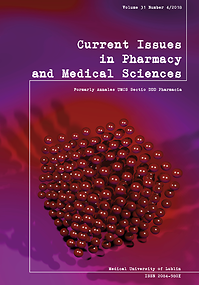Ultrastructural changes in murine liver following HSV infection and stroke
DOI:
https://doi.org/10.1515/cipms-2018-0002Keywords:
liver, ultrastructure, herpes simplex virus type I, strokeAbstract
The study of herpetic infection is a topical problem. Although the peculiarities and consequences of acute HSV-I infection in the brain are quite well-studied, little is known about the damage to other organs which are not a source of latent HSV-I infection, the liver in particular. The current study is aimed at determining the ultrastructural changes in murine liver following HSV infection and stroke. Liver samples obtained from four groups of animals were studied: 1) intact mice; 2) mice with stroke; 3) mice infected with HSV-I; 4) mice aflicted with HSV-I and subsequently simulated stroke. The study showed the reproduction of the virus in hepatic endotheliocytes, although no virions were detected in the hepatocytes. Therefore, the described changes were considered the consequences of the infectious process. Pathological changes of hepatocytes consisted of deformation and fragmentation of the nuclei, as well as accumulation of osmiophilic granules, lysosomes and lamellary bodies. Latent HSV-I infection may reactivate in liver after the stroke, potentially causing the complications of the underlying disease.References
1. Xu F, Schillinger JA, Sternberg MR, et al: Seroprevalence and coinfection with herpes simplex virus type 1 and type 2 in the United States, 1988-1994. J Infect Dis. 2002;185:1019-24. Google Scholar
2. Yao HW, Ling P, Tung YY, Hsu SM and Chen SH: In vivo reactivation of latent herpes simplex virus 1 in mice can occur in the brain before occurring in the trigeminal ganglion. J Virol. 2014;88: 11264-70. Google Scholar
3. Hara Y, Ishii N, Sakai K, et al. Herpes simplex encephalitis initially presented with parietal cortex lesions mimicking acute ischemic stroke: A case report. Rinsho Shinkeigaku 2016;56:104-7. Google Scholar
4. Pires de Mello CP, Bloom DC and Paixão IC: Herpes simplex virus type-1: replication, latency, reactivation and its antiviral targets. Antivir Ther. 2016;21:277-86. Google Scholar
5. Norvell JP, Blei AT, Jovanovic BD and Levitsky J: Herpes simplex virus hepatitis: an analysis of the published literature and institutional cases. Liver Transpl. 2007;13:1428-34. Google Scholar
6. Gumenyuk A, Motorna N, Rybalko S, Savosko S, Sokurenko L, Starosyla D, Porva Yu, Chaikovsky Yu. Development of herpetic infection associated with stroke and its correction with acyclovir. Curr Issues Pharm Med Sci. 2017;30(1):20-3. Google Scholar
7. Gumenyuk AV, Motorna NV, Rybalko SL, Savosko SI, Sokurenko LM and Chaikovsky YuB: Mutual influence of herpes virus infection activation and cerebral circulation impairment on the state of brain cells. Biopolym Cell 2016;32:126-30. Google Scholar
8. Navaneethan U, Lancaster E, Venkatesh PG, Wang J and Neff GW: Herpes simplex Virus hepatitis – It’s high time We Consider Empiric treatment. J Gastrointestin Liver Dis. 2011;20:93-6. Google Scholar
9. Ichai P, Roque Afonso AM, Sebagh M, et al: Herpes simplex virus-associated acute liver failure: a difficult diagnosis with a poor prognosis. Liver Transpl. 2005;11:1550-5. Google Scholar
10. Motorna N, Rybalko SL, Sokurenko LM, Starosyla DB, Savosko SI and Chaikovsky YuB. Patterns of herpetic infection reactivation in the liver. Microbiology Journal 2017;2:70-9. Google Scholar
11. Muscari A, Collini A, Fabbri E, Giovagnoli M, Napoli C, Rossi V, Vizioli L, Bonfiglioli A, Magalotti D, Puddu GM, and Zoli M. Changes of liver enzymes and bilirubin during ischemic stroke: mechanisms and possible significance. BMC Neurol. 2014;14:122. Google Scholar
12. Fujii Y, Takeuchi S, Tanaka R, et al: Liver dysfunction in spontaneous intracerebral hemorrhage. Neurosurgery 1994;35(4):592-6. Google Scholar
13. Hoya K, Tanaka Y, Uchida T, Takano I, Nagaishi M, Kowata K and Hyodo A. Intracerebral hemorrhage in patients with chronic liver disease. Neurol Med Chir (Tokyo) 2012;52(4):181-5. Google Scholar
Downloads
Published
Issue
Section
License
Copyright (c) 2018 Authors

This work is licensed under a Creative Commons Attribution-NonCommercial-NoDerivatives 3.0 Unported License.


